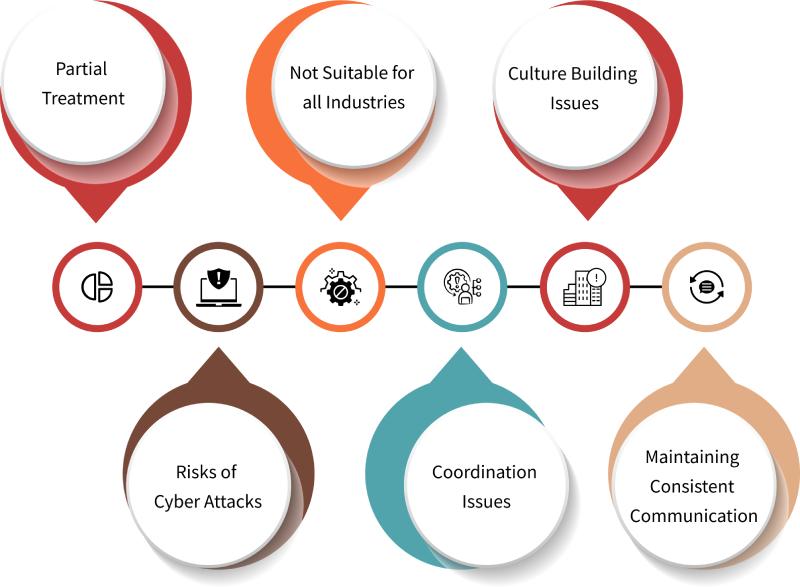The way we work has changed a lot,
and the hybrid work schedule is
leading the way. The old 9-to-5
office hours are less common now.
Instead, businesses see that
combining working
from home and in the office
gives workers the flexibility they
want and helps them work
better.
In this blog, we’ll
explain what a hybrid work schedule
means for your business, how it can
make employees happier and help your
operations run smoothly, and what
you need to do to make it
work.
Let’s get started!
What is a Hybrid Work Schedule?
A hybrid work schedule lets people work both at the office and home. Employees can work remotely on some days and from the office on other days. Employees don’t need to be in the office all the time, as well as they aren’t strictly remote workers either. This flexibility allows them to have a balance between work responsibilities and personal needs.
How Work Schedules Have Changed: From Traditional to Hybrid
Have you noticed how radically
working life has changed over the
past few years?
The reason for
the shift is the pandemic.
The
COVID-19 pandemic changed how people
work. Before the pandemic, most
employees had a regular 9-5 job and
needed to be in the office to get
their work done. But when everyone
had to
work from home during
lockdowns, it became clear that
being flexible was helpful. This led
many companies to start using a
hybrid work schedule.
According to a
McKinsey survey, 9 out of 10
organizations are switching to
hybrid work. Many companies now use
a mix of working at home and in the
office to help employees balance
their work and personal lives. This
lets employees decide where and when
they want to work, saving time on
travel and other costs. By letting
teams collaborate online and still
having an office for important
meetings, companies can help
everyone be more productive and
satisfied with their jobs.
The
pandemic also changed how managers
lead their teams. Instead of just
counting hours worked, managers now
focus more on trust and getting good
results. Companies are spending
money on technology to help people
work together online and are
offering training to help employees
adjust. As hybrid work keeps
growing, the focus on being flexible
for employees’ well-being will
likely shape the future of work for
a long time.
Types of Hybrid Work Schedules
Yes!
There are several types of
hybrid work schedules, and you can
implement the one that best suits
your organization and employees’
needs. Let’s have a look at them:
1. Cohort Schedules
Cohort schedules are a clear hybrid
work plan where all employees follow
the same schedule set by their
managers or the company. In this
setup, managers create a specific
plan that tells employees when to
work from the office and when to work
remotely. This schedule
helps team members work better
together by having the same days,
whether they are in the office or at
home.
For example, the
marketing team might go to the
office on Mondays and Tuesdays, and
the development team on Wednesdays
and Thursdays. This way, companies
can use office space better by
having different teams come in on
different days, which also helps
with teamwork.
a. 3/2 Hybrid Schedule
A 3/2 hybrid schedule means that
employees work 3 days in the office
and 2 days from home. The exact days
are usually decided by the
manager.
This schedule helps
employees work together in person
while also allowing them to work
from home. It gives them
both structure and freedom.
b. 2/3 Schedule
Well, this is exactly the same but vice-versa for the 3/2. This schedule allows employees to spend 2 days in the office and 3 days working remotely. Even this schedule is agreed upon with the manager.
2. Staggered Schedules
A staggered schedule is a way of
organizing employee’s work. In this
schedule, managers decide not only
which day employees should work
remotely or in the office
but also the exact time they should
arrive and leave. This schedule is
the most rigid cohort schedule and
is best for shift-driven
work.
Because everyone arrives
and departs at scheduled times, this
arrangement reduces crowding and
maximizes the utilization of
workplace space. For jobs that need
shift work, staggered schedules are
a great way for managers to maintain
a sufficient number of employees on
hand all day long while running at
less capacity.
3. Flexible Schedules
The name itself says about the
schedule. In this schedule,
employees can decide for themselves
when to work
from home and when to come
into the office.
Doesn’t it
sound good?
a. Flexi-place
A Flexi-place schedule allows employees to choose where they want to work each day, whether it’s from home, the office, or somewhere else, as long as they finish their weekly work hours. Companies can also use a desk booking system with this setup, where employees reserve a desk when they need to come into the office. This helps organizations save costs by using less office space because not everyone will be in the office together.
b. Flexi-time
Flexi-time lets workers choose when to work. They can pick their start and end times. But, they might need to be online during certain hours decided by their boss to make communication easier. However, they may need to be available during certain core hours set by management to support communication. You can also combine this schedule with other cohort schedules to provide even more flexibility for team members.
4. Team-Driven/ Bottom-up Schedule
In this flexible work setup, teams can choose how many days—and which days—they want to work in the office, depending on their needs. Some teams may need more time to spend at the office, while others might prefer working remotely for focused tasks. This approach gives employees manage over where they work while helping companies manage office space better. However, if you don’t coordinate schedules across teams, it can be hard to get everyone on the same page.
5. Company-Driven/ Top-down Schedule
Well, a top-down schedule is the exact opposite of a bottom-up schedule. In this schedule, management decides how many days and which days employees should work in the office and remotely. Organizations can set the schedule differently for each team or create one rule that applies to everyone.
6. Rotational Schedule
A rotational schedule in hybrid work means employees take turns working in the office and from home. Different groups or teams go to the office on certain days, while others work remotely on a weekly, bi-weekly, or monthly basis. This helps the company use office space wisely, while still giving employees the chance to work from home part of the time. It also allows for a good mix of teamwork in the office and focused work at home.
7. Job-role-specific hybrid Schedule
In this hybrid work approach, the schedule is made to the specific needs of each job role. Roles that require face-to-face interaction, may require to spend more time in the office. However, roles that require less teamwork and are more focused on individual work can have longer remote work days. This setup ensures that the workplace satisfies the requirements of every role.
How Do Hybrid Work Schedules Benefit Employees?
These days, more employees are
showing interest in hybrid work
because it offers them several
benefits, right?
Let’s have a
look at them:
Employee Satisfaction
A hybrid work schedule allows employees to choose when they want to work in the office and remotely. This flexibility allows employees to manage their lives better. When employees adjust their hours to meet personal needs helps them feel less stressed and more satisfied with their work.
Improves Productivity
According to
Gallup research, 51 % of
managers and employees noticed
higher levels of productivity in a
hybrid work environment.
Isn’t
it great to see that more than half
of the workforce feels they can get
more done when they have the
flexibility to choose where they
work?
Many employees find it
easier to concentrate at home
because there are fewer
distractions. It is actually easy to
set up a workspace that works for
them, whether it’s a quiet room or a
cozy spot. This balance helps them
get important work done well and
allows for better
teamwork when required.
Good Work-life Balance
Employees dream about perfect work-life balance and it becomes true with a hybrid work schedule. With this schedule, employees can spend their quality time with their family and friends which isn’t possible in traditional work. A hybrid schedule balances both the needs of employees and the goals of the organization.
Less Team Burnout
Employees in hybrid workplaces feel
less
burned out because they
spend less time commuting and can
work in ways that fit them
best.
No more team tensions,
hectic environment, boss pressures
every day. Employees can work freely
and are more likely to stay
productive without any
stress. Such flexible
schedules also reduce
pressures, such as constant
monitoring that happens in the
office.
How Hybrid Work Schedules Improve Business Outcomes?
You might think hybrid work only
benefits employees, but that’s not
the case!
It gives essential
advantages for the organization as
well.
Let’s have a look:
Better Talent Attraction and Retention
Many job seekers now like jobs that have flexible work options instead of the regular 9-to-5 hours. Such companies offering the facility to work from the office and home are more attractive because they allow people to work freely, flexibly, and strike a better balance between work and life. Also, flexible schedules help keep current employees, which reduces staff turnover.
Cost Savings
Hybrid
work schedules can help
companies save money because they
need less office space with fewer
employees in the office at the same
time. By making their office
smaller, businesses can cut costs
for things like electricity and
other bills. However, how much they
save depends on the type of hybrid
model they choose.
For example,
if different teams come in on
different days, companies can easily
cut down their office space. But if
all teams must be in the office on
the same days, they will need enough
desks for everyone, making it harder
to reduce space.
Adaptability and Resilience
Hybrid work setups help companies
adjust to changes and unexpected
events more easily. For example, if
there is a crisis like a natural
disaster occurs, businesses can
easily switch to remote work. This
allows employees to continue their
work remotely without losing
productivity.
A good
choice to either work from home or
in the office really makes it
comfortable for everyone involved
and helps keep the company running,
even during tough times.
Key Challenges of Implementing Hybrid Work Schedule

Partial Treatment
A hybrid work schedule can make some managers pay more attention to workers who are often in the office. Employees can choose where to work, some managers may give more raises and promotions to those who come to the office more, even if remote workers do the same amount of work.
Risks of Cyber Attacks
As more people work from home or mix office and remote work, the risk of cyberattacks has gone up a lot. Many workers use their own devices and home internet that aren’t safe, making it easier for hackers to steal company information. They might also get tricked by phishing scams if they don’t know about security rules. Working in public places with free Wi-Fi can put important information at even more risk. To help ensure remote work security, companies should make their security better, give regular training to workers, and encourage everyone to use safe devices and networks.
Not Suitable for all Industries
Hybrid work schedules don’t fit every industry because some jobs need workers to be there in person. For example, in hospitals, workers must be present to help patients and respond to emergencies. In factories, workers need to be there to use machines and check items. Since these jobs need hands-on work and teamwork, a hybrid model might not work well. Companies should think about what they need to find the best setup for their workers.
Coordination Issues
Coordination problems occur when team members don’t work well together, especially when some are in the office and others are at home. It can be hard to keep everyone on track, and tasks may get delayed if people don’t share updates or don’t know what others are doing. Without good planning and clear communication, work can feel messy, and important things may be missed.Teams need easy tools, frequent check-ins, and clear timetables to help everyone stay on the same page and collaborate effectively in order to address this.
Culture Building Issues
When people aren’t working at the same time they can start to feel left out and end up working alone. This makes it harder for managers to bring everyone’s work together because team members might not know what others are doing. Casual chats that usually help build teamwork don’t happen as often, leading to communication problems, feelings of unfair treatment, and trouble welcoming new workers. To keep a strong company culture that connects all employees, no matter where they work, businesses need to treat everyone fairly, talk openly, and have leaders who are involved.
Maintaining Consistent Communication
Keeping communication steady is a big
challenge in a hybrid work schedule.
With some workers in the office and
others at home, it’s hard to keep
everyone updated, leading to
confusion. In-person talks that
usually happen in the office are
less common, which makes it tougher
to build trust. Employees who work
remotely may experience feelings of
isolation and alienation, which can
hinder their productivity
and motivation. To help, businesses
should have regular meetings, use collaboration
tools to work together and
keep communication open so that
employees feel part of the team, no
matter where they are.
The hybrid
work challenges mentioned
above are quite common. It is
important to consider these problems
before implementing a hybrid work
schedule.
How to Establish a Flexible Hybrid Work Schedule

Define Clear Expectations
Make sure to explain what you expect from everyone. Start by setting clear goals and how to measure success for both in-office and remote work. When employees work from different places and at different times, it can be hard for managers to know if everyone is doing their job. You can even hold regular meetings to see everyone’s state and set down clear work, communication, and safety rules. This way, everyone understands what they need to do and stays connected to the company’s goals.
Communicate the Work
Culture to Employees
Before you
implement a hybrid work schedule,
communicate the work culture of
employees. Sharing the work culture
is important for building a strong
team. Employers can ask for feedback
on hybrid work preferences to see
what most people need and what
challenges they have. After you
decide on the hybrid work culture,
explain the work schedule and what
everyone needs to do. Put this
information in the employee handbook
so it’s easy to find. Good
communication helps create a
positive place where employees feel
included and want to help the
company do well.
Start with a Trail Period
Before fully starting a hybrid work
schedule, employers should try a
trial period of 15 to 30 days. This
trial helps them see how it works
and make changes if needed. It’s
important to involve employees by setting
clear goals and rules for
work hours and communication. Giving
them the right tools to work
together is also
important.
During the trial,
employers should often talk to
employees and ask for their thoughts
through surveys or group
discussions. This will help them see
how employees feel and find out if
there are any problems. At the end
of the trial, employers can look at
the results and see if they met
their goals, making changes based on
what employees said.
Get the Right Tools in Place
You don’t know how well your
employees are performing since it is
a hybrid work schedule. No proper
performance evaluation and results
will be seen if you don’t have the
proper tools. Organizations need to
use the best tools which helps
managers to get an idea about employee
performance.
Use Time
Champ, which is an employee
productivity and time
tracking software that helps
you to get a detailed overview of
your employees’ time
spent on different
activities. It helps you to
get an idea of where employees are
lacking and performing well.
Monitor the Work Progress
Checking on work progress regularly
is important for making a hybrid
work setup work well. Schedule
individual and team meetings to
review how everything is going. This
will keep every team member in
check.
Getting
feedback often is also
important. Employees can communicate
their ideas, challenges, and
thoughts in several methods. This
demonstrates that their views are
valued and contribute to better work
processes.
Final Thoughts
In conclusion, a hybrid work schedule can simply be stated as the integration of the in-office and the remote experience. This flexible way of work helps employees balance their personal lives and jobs better, which can lead to getting more done. To make it work, companies need to communicate clearly and give the right tools for teamwork. This way, it creates a positive work experience and success.
Want to enhance your hybrid team's performance?
Use Time Champ, your go-to productivity tool—get started today!
Signup for FreeBook DemoFrequently Asked Questions
It is important to think about what the job role involves. If jobs that need direct interaction, or special equipment might require more time in the office. But if the work is mostly independent or done on a computer, it can often be done from home.
To keep things fair, companies should focus on results, not where someone is working. By setting goals and giving regular feedback based on the work done helps avoid favoring people just because they are in the office. By following this, promotions are based on performance, not on physical presence.
Businesses can conduct regular online check-ins to get their work update. Use tools because it helps team to work together, and plan some in-person meetings. It’s also important to keep communication easy and make sure everyone feels like part of the team, whether they’re working from home or the office.
When setting office days, companies should think about when teams need to collaborate, when important meetings happen, and project deadlines. It’s also good to consider what days work best for employees. Scheduling office time around key activities that benefit from being in person helps things run smoothly while keeping flexibility.






